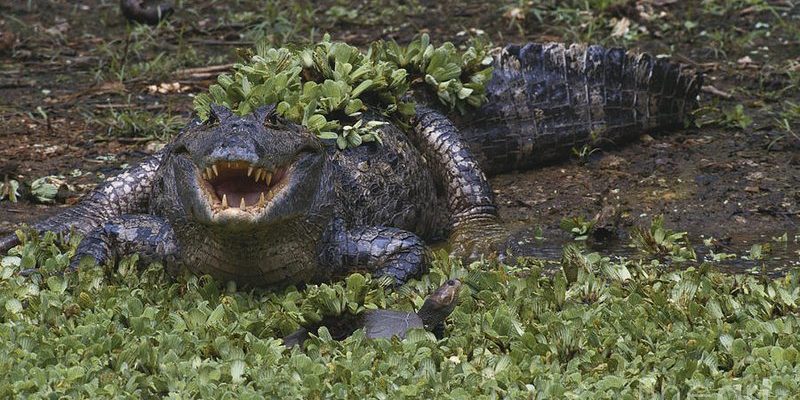
The Spectacled Caiman, a fascinating creature, blends seamlessly into its lush habitat. Picture yourself alongside a calm river, where the water is a bit murky and the sunlight dances across the surface. Suddenly, you spot a pair of eyes peeking out, perfectly camouflaged. That’s the Spectacled Caiman for you! This charming reptile is often found lounging along the banks of freshwater environments in Central and South America.
With their unique facial markings that give them their name, these caimans are more than just a pretty face. They play a vital role in their ecosystems, helping to keep populations of fish and other aquatic creatures in check. So, what makes the Spectacled Caiman so special? Let’s dive deeper to uncover their biology, behavior, and habitat!
Physical Characteristics
One of the first things you’ll notice about the Spectacled Caiman is its distinct look. These reptiles typically grow to about 6 to 8 feet long, making them one of the smaller caiman species. Their mangrove-green scales are not only beautiful but also serve as excellent camouflage. This helps them blend into the vegetation along riverbanks and lakes.
The name “Spectacled Caiman” comes from the unique bony ridge across their snouts, resembling glasses or spectacles. This feature plays a role beyond aesthetics; it aids in hunting. When they are in the water, only their eyes and nostrils peek above the surface, allowing them to remain hidden while surveying their surroundings.
Moreover, their teeth are designed not for chewing but for gripping slippery prey. With about 70 sharp teeth, they can capture fish, amphibians, and even small mammals. However, their diet can vary significantly based on their habitat and availability of food, which leads us to explore their eating habits next!
Habitat and Range
The Spectacled Caiman thrives in a variety of freshwater habitats. You’ll find them in swamps, lakes, rivers, and even in flooded forests. They are primarily located in countries such as Colombia, Venezuela, Brazil, and Peru. These reptiles are adaptable, which is why they can thrive in different environments—from dense jungles to open wetlands.
The temperatures in their habitats typically range from 70°F to 90°F (21°C to 32°C), making these warm regions perfect for basking in the sun. Caimans often spend time on land during the day, soaking up the sun to regulate their body temperature. They are mostly nocturnal, preferring to hunt and be active during the cooler evenings.
In terms of conservation, the Spectacled Caiman is currently listed as “Least Concern” by the IUCN, but they face threats from habitat destruction and hunting. Protecting their natural habitat is vital for ensuring their populations remain stable. By maintaining the health of these ecosystems, we contribute to the survival of not just the caimans, but the rich biodiversity they support.
Behavior and Diet
In the wild, the Spectacled Caiman displays a range of interesting behaviors. They are social creatures, often found in groups basking together. This communal basking helps them regulate their body temperature while also providing safety in numbers. However, they can be territorial, especially during mating season.
When it comes to feeding, these caimans are opportunistic hunters. Their diet predominantly consists of fish, but they also enjoy crustaceans, birds, and small mammals. Their hunting technique is quite effective; they rely on stealth, approaching their prey quietly in the water before making a quick lunge to capture it.
Interestingly, Spectacled Caimans have a unique feeding strategy. They often use a technique called “death roll” to subdue larger prey, spinning rapidly in the water to disorient their catch. This fascinating approach showcases their adaptability and efficiency as predators in their ecosystem.
Reproduction and Lifespan
During mating season, which tends to occur in the rainy months, male Spectacled Caimans engage in vocal displays to attract females. You might hear a series of deep, resonating sounds as they call out to potential mates. After successful mating, females will build nests out of vegetation and lay around 15 to 30 eggs.
The eggs incubate in the nest for about 80 days before hatching. Interestingly, the temperature of the nest can determine the sex of the hatchlings, a phenomenon observed in many reptiles. Higher temperatures often yield more males, while cooler temperatures lead to more females.
Once the hatchlings emerge, they are vulnerable and rely on their mother for protection. She plays a nurturing role, guiding them to water and keeping watch for predators. In the wild, Spectacled Caimans typically live for about 30 to 40 years, although some can live even longer in captivity.
Conservation Status
While the Spectacled Caiman is not currently endangered, several factors threaten their populations. Habitat destruction due to agriculture, urbanization, and pollution poses significant risks. Additionally, they have historically been hunted for their skins. However, conservation efforts have helped stabilize some populations.
Protected areas and wildlife reserves play a crucial role in preserving their natural habitat. Education and awareness programs encourage local communities to engage in conservation practices. By understanding the importance of these creatures in their ecosystems, we can collectively uphold conservation efforts for the future.
Fascinating Facts
| Average Length: | 6 to 8 feet |
| Average Weight: | 60 to 100 pounds |
| Habitat: | Freshwater rivers, lakes, swamps |
| Diet: | Fish, birds, small mammals |
| Lifespan: | 30 to 40 years |
| Conservation Status: | Least Concern |
FAQ
What does the Spectacled Caiman eat?
The Spectacled Caiman has a varied diet, primarily consisting of fish, amphibians, and small mammals. They are opportunistic feeders, meaning they will eat whatever prey is available. Their sharp teeth and stealthy approach help them catch slippery fish with ease.
Are Spectacled Caimans dangerous to humans?
While Spectacled Caimans are predators, they generally avoid human interaction. They may defend themselves if threatened but typically prefer to retreat from humans. That said, it’s always wise to observe wildlife from a safe distance to avoid any potential conflicts.
How do Spectacled Caimans regulate their body temperature?
Caimans are ectothermic, meaning they rely on external heat sources to regulate their body temperature. They bask in the sun on riverbanks or rocks to warm up and cool down by swimming in the water. This behavior is essential for their metabolism and overall health.
Do Spectacled Caimans have any natural predators?
Yes, hatchlings are particularly vulnerable to predators like birds and larger fish. Adult Spectacled Caimans have fewer natural predators, though they can fall prey to larger crocodilians or humans. Their size and strength usually help them avoid most threats as they grow.
How can I help protect the Spectacled Caiman?
You can contribute to conservation efforts by supporting organizations that focus on wildlife protection, participating in clean-up initiatives in natural habitats, and spreading awareness about the importance of these reptiles. Learning about their role in ecosystems can also help foster respect and understanding.
What is the difference between a caiman and a crocodile?
While both belong to the same family, there are several differences between caimans and crocodiles. Caimans tend to have shorter, broader snouts and are generally smaller than crocodiles. Their habitats also differ, as caimans are primarily found in freshwater, while many crocodiles can inhabit saltwater environments.
Can Spectacled Caimans coexist with other wildlife?
Yes, Spectacled Caimans can coexist with a variety of wildlife in their ecosystems. They play a vital role in controlling fish populations and, in turn, their presence supports a balanced aquatic environment. However, maintaining healthy habitats is crucial for all species living in these areas.
How do Spectacled Caimans communicate?
These reptiles communicate through various vocalizations, especially during mating season when males call to attract females. They can also use posturing and body language to establish territory and communicate aggression or courtship. Their vocal sounds can be quite deep and resonate over long distances.
What environmental threats do Spectacled Caimans face?
Key threats include habitat loss due to agricultural expansion, pollution from chemicals, and hunting for their skins. Climate change poses additional risks, especially with rising water levels and changing weather patterns impacting their habitats. Addressing these issues is essential for their survival.
How long do Spectacled Caimans stay with their mothers?
After hatching, young Spectacled Caimans rely on their mothers for protection and guidance for several months. During this time, she will help them find food and avoid danger. Eventually, the young caimans grow independent and start to venture out on their own.

